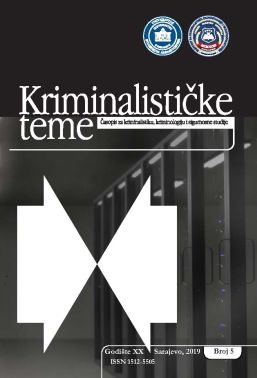KORIŠTENJE KOMERCIJALNE TEHNOLOGIJE U SUZBIJANJU I PRAĆENJU NEZAKONITE TRGOVINE ŽIVOTINJSKIM TROFEJIMA U CYBER-KRIMINALNIM TRGOVINSKIM MREŽAMA
USE OF COMMERCIAL TECHNOLOGY IN COUNTERING ILLEGAL WILDLIFE TRAFFICKING WITHIN CYBER-CRIMINAL TRADE NETWORKS
Author(s): Amer Smailbegović, Nedžad KorajlićSubject(s): Business Economy / Management, Criminal Law, Criminology, ICT Information and Communications Technologies
Published by: Fakultet za kriminalistiku, kriminologiju i sigurnosne studije Univerziteta u Sarajevu
Keywords: Poaching; Smuggling; Trans-national crime; Reconnaissance;
Summary/Abstract: Reason for writing and research problem (s): Similar to the other forms of illegal trade, poaching and trafficking of endangered wildlife is a serious transnational organized crime that generates billions of dollars per year, with fast and unimpeded income, directly into the hands of criminals. Aims of the paper (scientific and/or social): With low detection-risk and high-earning potential, along with expanding worldwide Internet access, transnational criminals continue to thrive in these particular illegal activities. Methodology/Design: Although wildlife traffic falls within a broader range of cybercrime, a more appropriate description would describe it as a traditional form of criminal activity that uses new cyber-technologies and means of access to further the illegal trade. Research/Paper limitation: In addition to the many legal and law-enforcement challenges associated with the conventional offenses for the marketing or promotion of illicit wildlife trophies, the online trade poses another set of problems for officials, forcing them to operate in a trans-judicial, virtual space in which they, and the law, are mostly unprepared for. Results/Findings: In the prevention phase, law enforcement and security forces lack the rapid response and effective use of intelligence obtained from the open-source or intelligence assets. Most poaching and subsequent traffic and smuggling activities, occur under the cover of darkness, but within discrete geographical regions with relatively predictable patterns. General Conclusion: In the direct-response phase, the methods and material resources available can be used to monitor the means of transporting smuggled goods and directing response teams, either by responding to the interception of the offender or incorporating the obtained information into the wider picture of unmasking and combating the transnational crime syndicates. Research/Paper Validity: Using relatively simple domain tracking, data traffic and passive communication monitoring, combined with the civil-commercial technology for the tracking and detection of communication devices, rapid aircraft response and communication capabilities, we have been able to develop a long-term, ongoing critical area monitoring. This capability uses the area-of-interest determination and ground task-force targeting for the purpose of intercepting the poachers before they carry-out their intentions.
Journal: Kriminalističke teme – Časopis za kriminalistiku, kriminologiju i sigurnosne studije
- Issue Year: XIX/2019
- Issue No: 5
- Page Range: 313-329
- Page Count: 17
- Language: Bosnian, Croatian, Serbian

